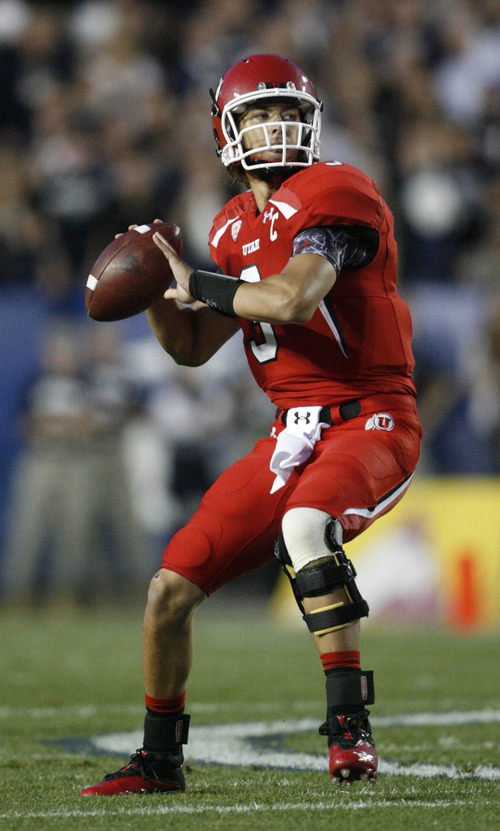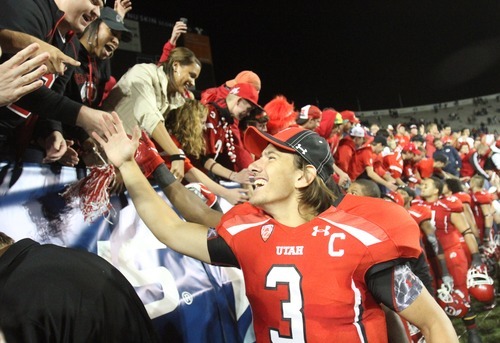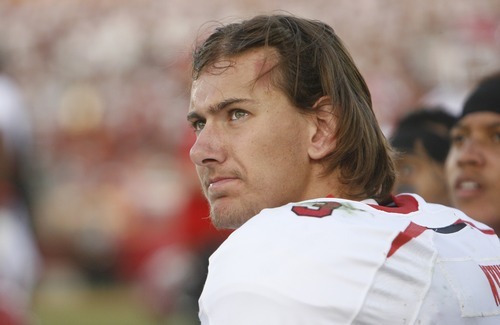This is an archived article that was published on sltrib.com in 2011, and information in the article may be outdated. It is provided only for personal research purposes and may not be reprinted.
Jordan Wynn's goal is to be considered among the great quarterbacks of the Pac-12. He is better off aiming to be the next Drew Brees, some believe.
Wynn, whose surgically repaired shoulder has been the subject of more discussions and conspiracy theories than any other athlete's body part in recent memory, is no longer commenting on his shoulder, preferring to let the results on the field speak to his health.
"I'm 100 percent and I feel good," has been his constant refrain.
But anyone who has seen Wynn throw knows things are different, even on days such as last Saturday, when he threw for 239 yards in Utah's win over BYU.
He has improved since the opener when he threw for just 101 yards, but Wynn still has a ways to go. That sidearm throwing motion of his and those too-short passes? They're all part of the healing process athletes such as Wynn must endure. Even if he feels fine, he isn't always fine on the field.
Being 100 percent and being able to reach what surgeon Charles L. Beck calls "maximum peak potential" are two different things.
Beck, a specialist in knee and shoulder injuries who is based out of the Center of Orthopedic and Rehabilitation Excellence in West Jordan, can't speak directly of Wynn's injury and surgery.
However, Beck is familiar enough with shoulder surgeries to speak of the general challenges in recovery athletes face. In his judgement, Wynn or any other athlete with a throwing motion is doing remarkably well to be participating in their sport less than a year after surgery.
"People think just because you have a scope and you aren't cutting through muscle that the surgeries aren't invasive, but to recover from one takes a long time, particularly in the shoulder," he said. "For an athlete to undergo shoulder surgery, it takes 1 to 2 years to reach maximum peak performance. Anyone who is in their sport less than a year out from surgery is doing remarkably well."
So, while Wynn might feel he is 100 percent, it's likely it will be more than a year before he returns to the level of play he reached pre-injury.
Rather than try to be like the next Matt Barkley or Andrew Luck, Wynn realistically could be more like Brees, the New Orleans Saints quarterback who tore his rotator cuff and labrum while playing for the San Diego Chargers in 2005.
Brees returned to the field in 2006, but it wasn't until 2007 that he returned to his pre-injury form, passing for 4,428 yards, tying a Saints record with 28 touchdowns and setting an NFL record for pass completions in a single season with 440.
Brees' numbers were even better in 2008 and he earned MVP honors in 2009 when he led the Saints to the Super Bowl.
Like Brees, Wynn has endured a lot of criticism and skepticism from Utah fans who see his sidearm throwing motion or his uncertainty in the pocket.
But those fans probably don't understand the timeline it takes to recover from an injury both physically and mentally, observers say.
ESPN analyst Kirk Herbstreit, who has followed Wynn's development as a Utah quarterback, said he has been impressed with the way Wynn has handled himself.
He predicts Wynn will continue to improve as he gets more comfortable in game situations.
"Anytime a pitcher or quarterback has work like that done and turns around and executes, it's hard," said Herbstreit, a former quarterback for Ohio State. "It's one thing to throw in practice and another to throw when the USC defense is coming after you. I think that the more he is playing the more he'll get back to his old self. It was a big surgery he had and I'm happy he is out there and it shows the courage and guts he has."
Recovery time is extended for shoulder injuries, Beck said, due to the nature of the structures involved.
"The shoulder is a big ball-and-socket joint that attaches to the shoulder blade," Beck said. "You do so many rotational things with it, we've found you have to give it time to more time to heal than other joints after surgery. Then you've got some stiffening up in the area because you have to immobilize it. You have a lot of areas you have to work on strengthening and coordination and that takes time. It's a very labor intensive process."
As for the sidearm motion, it might drive fans crazy to see it, but it's likely a symptom of the tightness in the shoulder following surgery. Beck said range-of-motion problems are common post-surgery, particularly for athletes who must throw. However, they do gradually get better.
"It gets stiff and you have to work on re-coordinating the whole body," he said. "It may not function as a proper throwing shoulder for more than a year."
Wynn recently acknowledged his motion was different but said he wasn't trying to change it.
"I don't get into looking at my motion or trying to change it back; that is kind of how you overanalyze things, so I am just going to go out and throw it," he said.
While Utah fans might not be patient with Wynn, even though wins such as Saturday's go a long ways in silencing the critics, the Utes are willing to let Wynn work back to his old form.
Utah coach Kyle Whittingham was critical of Wynn following his 101-passing yard performance in the opener, but has since backed his quarterback.
"He is a tough kid," Whittingham said. "He is mentally tough and he is a competitor and he has done well. He has been patient and accommodating with everyone, but we're done talking about his shoulder. It's no longer a topic for us."
Instead, it's a work in progress.
lwodraska@sltrib.comTwitter: @lyawodraska —
Wynn after three games
Opponent C-A Yds TDs
vs. Mont. St. 15-23 101 2
at USC 23-46 238 1
at BYU 16-30 239 2







